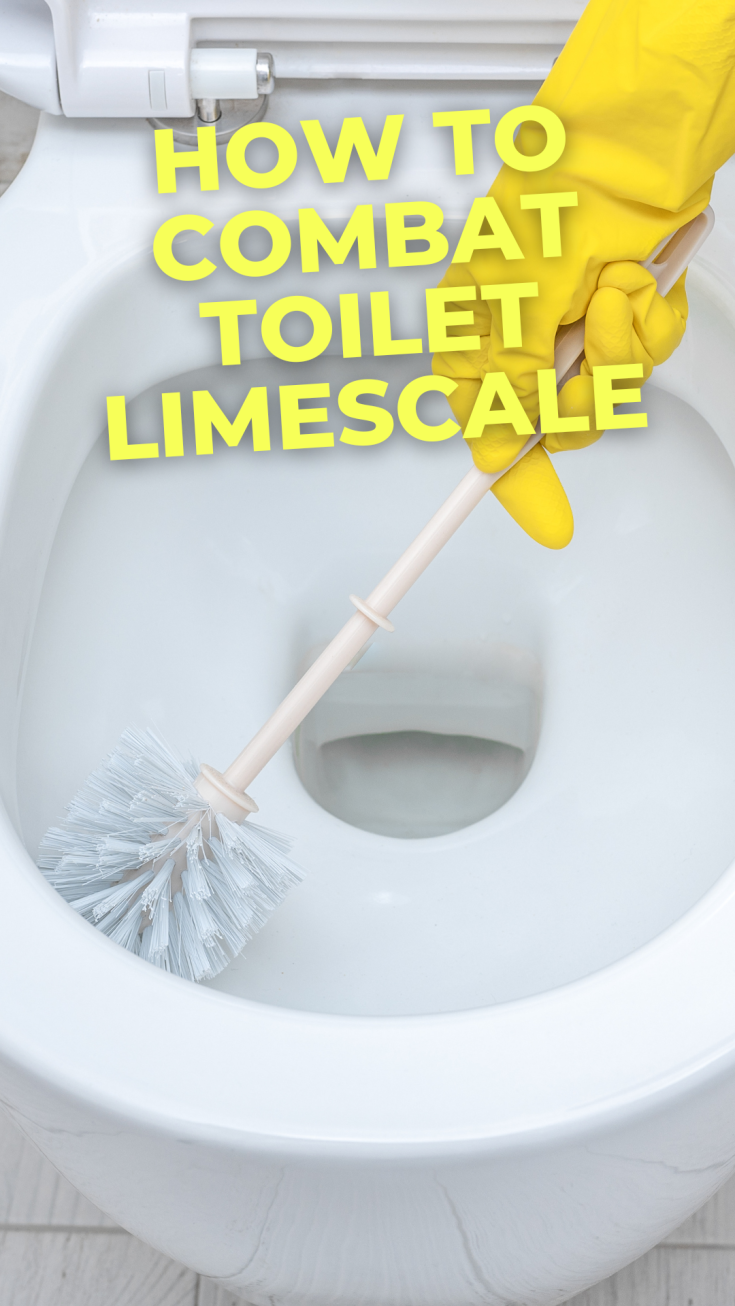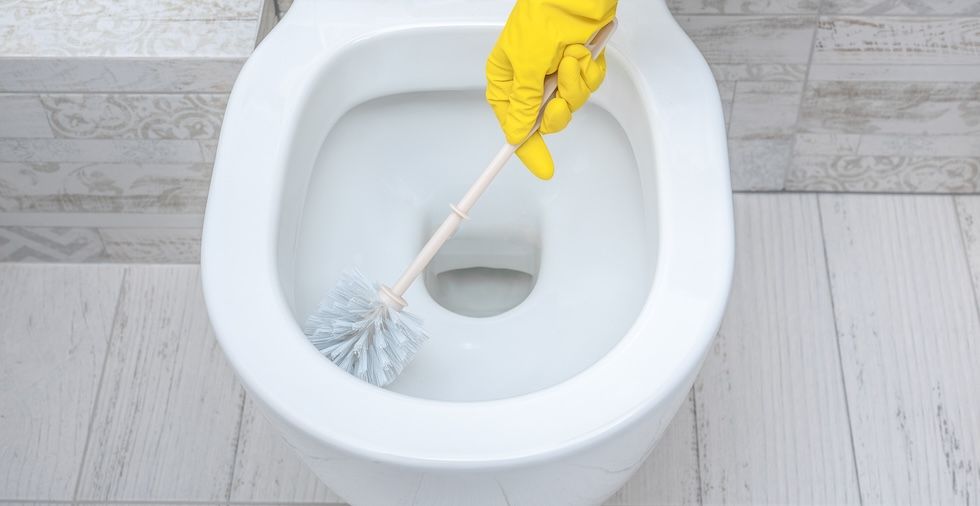- What are the causes of limescale?
- How to remove limescale from the toilet
- How to choose the best limescale remover for toilets
- Tips & tricks for preventing limescale buildup
- Using baking soda to clean limescale in the toilet
- The importance of regular cleaning and maintenance
Limescale buildup in the toilet may be an annoying and unappealing problem for many homeowners. It not only reduces the cleanliness of the toilet bowl, but it can also be challenging to remove. So, what should you do when you find limescale in the toilet?
In the following post, we'll examine practical ways to remove limescale from the toilet, especially brown limescale, and prevent it from returning. We will also look at the reasons for limescale buildup and the best limescale removers for toilets. Following our tips will ensure you keep your toilet clean and limescale-free.
What are the causes of limescale?
When hard water evaporates and leaves behind dissolved minerals, a mineral deposit known as limescale, or calcium carbonate, is created. Calcium and magnesium ions are commonly found in high amounts in hard water.
These ions mix with carbonate ions from dissolved carbon dioxide in the atmosphere during the evaporation of hard water to produce insoluble calcium carbonate. This calcium carbonate gradually builds up on surfaces like shower heads, faucets, and toilet bowl interiors to form limescale, a hard, crusty accumulation.
In places with hard water, limescale buildup in toilets is a frequent occurrence. Calcium carbonate deposits are left behind when water evaporates from the toilet bowl and accumulates over time. As a result, there may be unattractive stains, discolouration, and a thick layer of limescale that is difficult to remove.
Depending on the makeup of the water source, limescale in toilets may contain additional minerals and contaminants in addition to calcium carbonate. For instance, iron in the water is frequently the reason behind dark limescale stains in toilets. Rust is created when iron oxidises and mixes with atmospheric oxygen, leaving brown stains on surfaces.
While this article talks about removing limescale from a toilet, be sure to find out how to clean a shower head, how to clean soap scum, and how to remove rust next.
How to remove limescale from the toilet
When getting rid of limescale from the toilet bowl, use an effective cleaning solution and method. Here are two of the options that you might want to consider:
- Commercial limescale removers are widely available and specially developed for this purpose. Compare the best limescale cleaners and choose one that works. When you invest in one of these products, read the back of the packaging to see how to use it. Often enough, you should cover the limescale and then rinse it off for the best results.
- DIY vinegar and baking soda solutions can be both effective and environmentally beneficial. Pour the solution generously into the toilet bowl, covering all limescale-affected areas. Allow the solution to remain undisturbed for at least 30 to 60 minutes. During this period, the acidic characteristics of vinegar and the abrasive action of baking soda combine to break down and dissolve the limescale buildup. After the specified time, use a toilet brush to scrub the inside. Repeat the process multiple times.
Which of the above works will depend largely on how thick the limescale is. If you have a load of limescale buildup, you may need to repeat the process as often as necessary. Once you have finished this process, be sure to clean your toilet bowl thoroughly.
How to choose the best limescale remover for toilets
Selecting the appropriate limescale remover for your toilet is a must if you want to effectively fight limescale buildup and keep the bowl sparkling. An effective remover is necessary since it can eliminate limescale without harming your toilet's porcelain or other elements.
Choose limescale removers that are designed especially for use in toilets. These products are made to be both safe and efficient for use on toilet surfaces, guaranteeing a deep clean without risk of damage. Search for substances known for efficiently dissolving limescale, such as hydrochloric or citric acids.
Steer clear of harsh chemicals and cleansers with bleach bases. They can be abrasive and, over time, harm your toilet's porcelain surface. In addition to detracting from the toilet's appearance, surface damage can increase the likelihood of future stains and limescale accumulation.
To reduce environmental impact, consider biodegradable solutions that are safe for septic systems. Eco-friendly products are just as efficient at removing limescale.
Cleaning, upkeep, and preventive measures must all be used to combat limescale in the toilet. You can maintain a clean and limescale-free toilet by being aware of the reasons behind its growth and choosing effective cleaning methods.
Try our homemade bathroom cleaner next!
Bonus: Cleaning the toilet rim & other hard-to-reach areas
Limescale accumulates in the most inaccessible areas of the toilet, particularly the rim and underneath. To treat these places properly, soak a cloth or sponge in the limescale removal solution and clean the surface.
To remove stubborn limescale deposits, use a scrub brush or an old toothbrush to accumulate friction. Once the cleaning process is complete, carefully rinse the treated areas with water to remove any remaining residue.
Tips & tricks for preventing limescale buildup
Want to prevent limescale buildup in the first place? When you have thoroughly cleaned your toilet, you need to maintain it. Here are some of the tips and tricks you can use:
- Soften the water: Installing a water softener, a device designed to remove the minerals that cause hard water, is one highly effective technique for preventing limescale.
- Use a toilet bowl cleaner: Getting a cleaner designed to prevent limescale formation can also help keep the toilet clean. Consistent cleaning with a mild acid-based cleanser strengthens the defence as well.
- Wipe the interior of the bowl: Additionally, making it a habit to wipe out the interior of the toilet bowl and other surfaces with a squeegee after each use will effectively remove surplus water.
Using baking soda to clean limescale in the toilet
Did you know you can clean your toilet with baking soda? To begin, liberally dust the inside of the toilet bowl with baking soda, making sure to cover all areas where there is a limescale buildup.
Subsequently, mist the baking soda with vinegar to initiate a chemical reaction that will cause fizzing and bubbling when the two materials react with the limescale deposits.
Let this strong concoction sit for at least half an hour, giving the vinegar and baking soda time to seep in and dissolve. Once the necessary amount of time has passed, use a toilet brush to scrub the inside of the bowl very hard, moving and breaking up the softened limescale.
Lastly, flush the toilet to completely remove the dissolved residue and leave a clean, shiny bowl free of limescale.
The importance of regular cleaning and maintenance
To prevent limescale, make it a habit to clean the toilet bowl and its surrounding surfaces regularly. During these cleaning sessions, use a moderate acid-based cleanser or a commercial limescale remover, thoroughly covering all areas that could become covered with limescale, such as the inside of the bowl, the rim, and underneath the rim.
Furthermore, consider including preventive actions in your monthly maintenance, such as adding a water softener or cleaning your toilet bowl with a specific cleaner designed to avoid buildup.
Preventive steps like installing a water softener or using an antibacterial toilet bowl cleanser can help keep limescale away in the future, making this one of the stress-free ways to clean your bathroom. Regular cleaning with a store-bought remover or a DIY solution of vinegar and baking soda can help in removing existing deposits, too. You can have a clean and hygienic toilet without the inconvenience of limescale buildup. You can use the approaches we have shared here.
For more tips on how to remove limescale, take a look at our other article. Make sure you know how to clean a kettle, too! Limescale removal methods vary for every part of the home.
We're also answering questions like can you flush hair down the toilet and sharing some of the best toilet paper alternatives.
Q&A
Looking for some more answers? Here are some frequently asked questions about cleaning limescale in the toilet.
What is the best limescale remover?
There are many different limescale removers on the market. However, when choosing the best one to use, make sure it has an acidic base. Limescale is alkaline, so this cleaner will cut right through it.
Does Coke remove limescale?
While Coke is acidic, you should probably avoid using it as an everyday household cleaner. It may cut through the limescale, but because it contains sugar, it can leave a sticky residue.
Can lemon remove limescale?
Lemon juice is acidic, so you can use it to break down limescale. However, it is advisable to use other cleaners as well. It may be worth using a variety of approaches when it comes to cleaning your toilet bowl. That way, it will sparkle and stay as pristine as possible.
Have you tried our tips? Let us know in the comments below!


What a great life hack!
We're glad you think so!